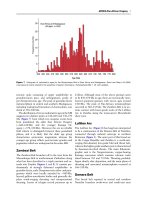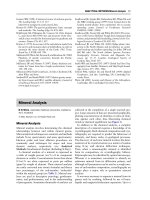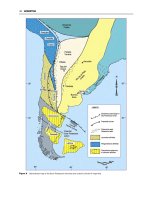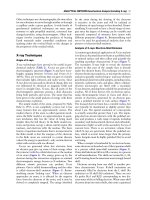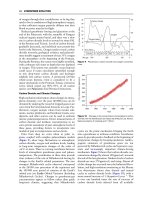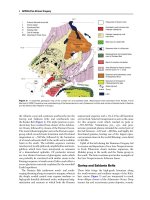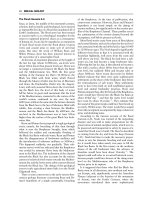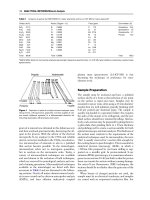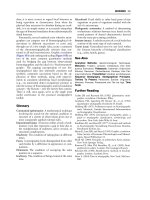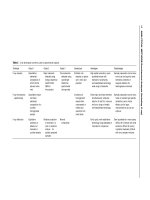Encyclopedia of geology, five volume set, volume 1 5 (encyclopedia of geology series) ( PDFDrive ) 3090
Bạn đang xem bản rút gọn của tài liệu. Xem và tải ngay bản đầy đủ của tài liệu tại đây (159.67 KB, 1 trang )
UNIDIRECTIONAL AQUEOUS FLOW 553
curvature, abrupt gradient changes at the edge of
subaqueous slopes, and subaqueous topography.
One key consequence of flow separation is that a
steep velocity gradient and shear layer are generated
between the separation zone and the faster freestream fluid outside: large-scale coherent vortices,
termed Kelvin–Helmholtz instabilities, are generated
along this shear layer. Such large-scale vortices are
highly turbulent and may be responsible for generating large instantaneous Reynolds stresses, which are
often critical in erosion of the bed and sediment
transport.
Free Shear Layers
In addition to shear layers associated with flow separation, zones of distinct differential velocity and
rapid change in velocity may be present within the
body of a unidirectional flow, owing to flow convergence around topography or in combining channels
or to shear at the top of a subaqueous density current,
for example. Turbulence and mixing across such ‘free’
shear layers depend on the velocity differential across
the shear layer and the relative densities and viscosities of the two incoming flows, but these free shear
layers often create large-scale Kelvin–Helmholtz instabilities (Figure 9), which dominate both fluid
mixing and the instantaneous Reynolds stresses. For
example, fluid mixing at channel confluences (Figure
9) has been shown to be greatly influenced by the
shear-layer dynamics between the incoming flows,
and interactions between free shear layer and bed
topography are thought to control the downstream
dispersal of suspended sediments and pollutants.
Figure 10 (A) Flow regions associated with the presence of a pebble cluster on the turbulent flow field. (B) Schematic diagram of the
large scale flow structures proposed to develop over a rough gravel surface, showing (top) how the passage of a large scale high
speed flow structure expands the flow separation zone in the lee of the clast and (bottom) how this generates vortex shedding from the
separation zone and upwelling in the region of flow reattachment. Both A and B are reproduced from Buffin Belanger T and Roy AG
(1998) Effects of a pebble cluster on the turbulent structure of a depth limited flow in a gravel bed river. Geomorphology 25: 249 267.
